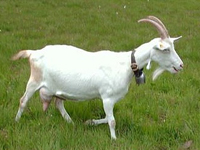

 |

|
 Saanen Domestic Goat |
Saanen Domestic Goat(Mammal) |
 Saanen Domestic Goat Baby |
Saanen Domestic Goat HabitsAlthough wild goats still roam freely in barren, mountainous regions throughout much of the world, the Saanen goat thrives best in groups of other domesticated goats.
A long history of domestication has given this goat a mild nature which makes it easily manageable. Furthermore, it dislikes cold or wet weather and needs access to shelter at all times, so herds are often kept permanently indoors, either in individual stalls or in covered yards. |
Saanen Domestic Goat CommunicationGoats communicate with each other by bleating, what many people call the baaah sound. Goats will bleat when stressed, hungry, or calling for attention from keepers. Does (females) will also call to their kids. |
Saanen Domestic Goat BreedingSince the Saanen is bred solely for its milk, most goat farmers keep only females, called does. The males, or bucks, are expensive to maintain and, by mating with its own offspring,
would give rise to inbreeding. So once a year, small-scale goat breeders must take their does to a stud buck to be mated. Artificial insemination is often used on large farms.
The doe comes into estrus every three weeks between September and February. A female kid (young goat) comes into estrus her first year, but is usually not mated until she is 18 months old. Ideally, the doe will be mated in November or December, so that her kids mill be born in the spring.
Twins are common and are showed to feed from their mother for four days. They will :hen be bottle-fed so their mother can be milked. When the kids are 10 days old, the farmer will begin to feed them hay. Male kids are generally fattened and killed for their meat at six months of age. |
Saanen Domestic Goat Food & FeedingThe goat is principally a browser, rather than a grazer. This means that it is specially adapted to feed on tough, fibrous vegetation such as brambles, twigs, and shrubs, rather than on grass. Unfairly blamed for creating much of the world's desert, the Saanen domestic goat is often simply the last animal to survive in barren country.
The modern Saanen has adapted to a diet containing a high proportion of grass. Where grass is in short supply, the farmer will give the goat extra feed such as hay, kale, cabbages, and potatoes. |
Saanen Domestic Goat Key Facts |
| Size |
| Height: 28-32 inches at shoulder |
| Weight: Does: 130 pounds, Bucks: 175 pounds |
| Breeding |
| Sexual maturity: Does at 6 months, Bucks at 3 months |
| Mating: September to February |
| Gestation: 150 days |
| Number of young: Usually 2, but 1 or 3 is not uncommon |
| Lifestyle |
| Habit: Sociable, inquisitive |
| Diet: Fibrous, woody vegetation, herbs and grass, usually supllemented with vitamins |
| Lifespan: 14-15 years |
DID YOU KNOW?
|
CAN'T FIND WHAT YOU'RE LOOKING FOR? CLICK HERE!!!